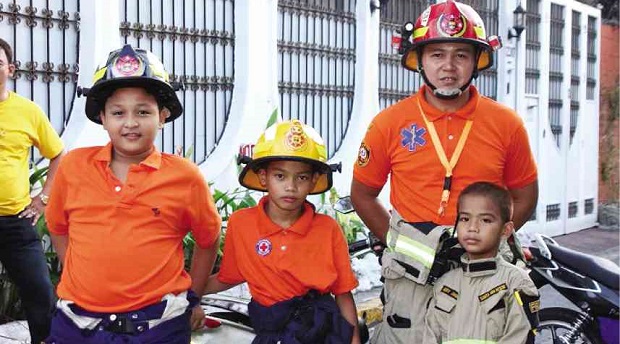
RESCUE 101 Nino Sta. Brigida (second from right), founder of Sta. Ana Help and Emergency Lifeline Inc., has formed a volunteer group of rescuers and firefighters composed of friends and neighbors, including a “junior brigade’’ who helps monitor his Sta. Ana community. CONTRIBUTED PHOTO
WITH only a scooter to help him move around, Nino Sta. Brigida started gathering volunteers in his community two years ago to establish the Sta. Ana Help and Emergency Lifeline Inc., now known in the Manila district simply as Sta. Ana Rescue.
Formed to serve as a quick-reaction team augmenting government response units, the group has since grown from a mere five members in 2012 to a current strength of 40, including a “junior brigade” made up of young boys tapped as monitors.
It has been particularly helpful to the Manila fire department, fulfilling Sta. Brigida’s longtime mission “since high school” to organize a firefighting team composed of friends or neighbors.
“I have witnessed big fires here in our locality where many people lost their lives because of the lack of immediate rescue and response,” said Sta. Brigida, 38, who left his job as a Physical Education teacher in a Quezon City private school to focus on the group he founded.
Most of the current members have regular jobs but are eager to keep their eyes and ears open for any emergency in the area and spring into action. “Some of them are seafarers waiting for their next trip while others are band musicians,” he said. “I admire their dedication to our cause.”
To prepare, the Sta. Ana volunteers underwent training in seminars conducted by the Bureau of Fire Protection (BFP), where they were taught the basics of fire fighting and rescue procedures.
Lacking funds to buy proper gear and equipment at that time, Sta. Brigida initially used his own money to buy the first five uniforms for the team. Today, the group mostly relies on donations from the local government, civic groups and private benefactors for financial support.
Having no office or headquarters, they hold weekly meetings at his house or on the sidewalk, and just rely on text messages to coordinate their moves.
“Our members posted at the Sta. Ana Fire Station take shifts in monitoring emergencies and they join the fire brigade during operations,” he said.
“When we started offering our help to the station, however, the fire department chief expressed concern over our safety.”
But the group insisted on tagging along, freeing the firemen of any liability in case anything untoward happens to the volunteers while in action. Thanks to their training, their injuries have been limited to bruises and minor cuts.
A logbook kept by Sta. Ana Rescue showed it had so far responded to more than a hundred fires in Sta. Ana and other parts of Manila, as well as about 50 other emergencies arising from street crimes and accidents.
But not everyone in the community welcomes them as heroes. Once, they were sneered at for being “pakialamero (meddlesome)” for responding to a child abuse case. “Last Feb. 22, we rescued a 10-year-old boy who was handcuffed by his own uncle inside their residence on Medel Street,” he shared.
Their detractors even included some barangay councilors in Sta. Ana. “I think that is the price I have to pay for wanting to help others and put order in the district,” he noted.
Yet the group remains undeterred and even tries to keep itself busy in between emergencies. Recently, it conducted a training session on rescue and self-defense techniques for minors aged nine to 14. “We hope to shape them into helpful citizens in the future.”
Sta. Brigida noted that fires in the metropolis were becoming harder to contain due to the narrow streets and alleys, crowded neighborhoods, and the proliferation of highly combustible building materials.
This observation, he said, had lent urgency to his next big project: Procuring the team’s own fire truck. Now seeking donors for this purpose, he hopes to realize this goal within the year.
“Now, more than ever, we need modern-day heroes like firefighters and rescuers to step up. I believe there are people out there who want to help others simply because they want to,” he said.